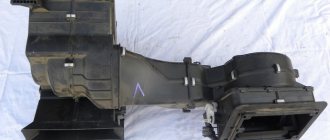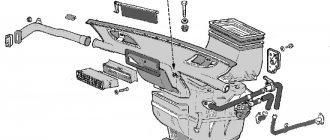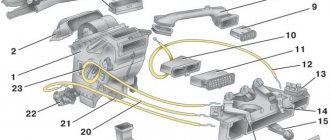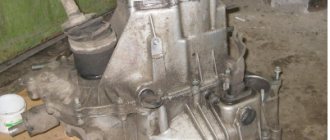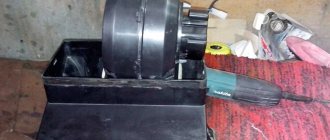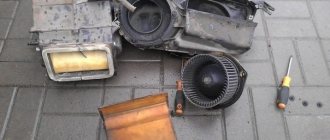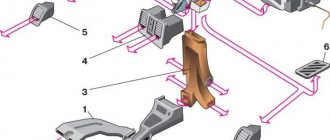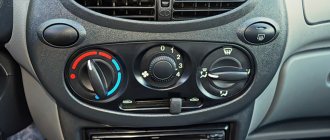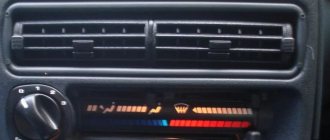The main purpose of a stove heater is to maintain a given temperature in the car interior, as well as to ensure an uninterrupted supply of oxygen inside.
Type of ventilation: supply and exhaust.
Heating circuit of Lada Granta: control is carried out by mechanical regulators that change the air flow speed and the direction of the damper.
In order to prevent unpleasant odors from entering the cabin, a cable-type air flow intake switch is pre-installed.
Elements of the Lada Granta heating system
Let's look at the design of the Lada Granta stove in the “Norma” configuration:
- radiator;
- three air pipes supplying flow to the left/right/central deflectors;
- control module;
- radiator housing;
- rubber seals;
- fan;
- fan housing;
- cables, mechanical rods of dampers;
- regulator resistors.
Heater radiator
In the modification with a pre-installed air conditioner, the list is supplemented by a separate air duct, evaporator, and heater unit housing.
How does a stove fan work?
The main task of the fan is to take air flow from the outside and deliver it to the deflectors.
The fan is activated by a mechanical button, to which a 12 V power supply is supplied. In the Lada Granta version, the fan operates at one of three speeds. The driver selects the most optimal mode depending on the temperature inside the cabin.
Additional resistors Grants
Without resistors, the fan operates at one speed with a stable rpm. There are a total of 3 resistors installed on the board.
When the lever is moved to the first position (three resistors), the fan rotates at the first speed, the very minimum. Transfer to the second position - second speed (two resistors). Transfer to third - third speed (one resistor). The detailed diagram of the stove is shown in the photo.
Air distributor flap
Installed to regulate the air flow coming from the fan to the glass for blowing through air ducts.
Often, deformation and bending of the plastic body under the influence of temperature leads to flow leakage and depressurization.
Temperature control flap
Regulates the supply of warm air flow from the stove heater to the car interior. The wider the damper is open, the greater the throughput of the “channel”, and vice versa, the narrower it is, the less.
Heat exchanger Grants
Its main purpose is to heat the air flow entering the cabin. The heat exchanger is connected to the power unit through two rubber pipes: supply and return for fluid circulation.
The standard location is the central part of the dashboard of the car interior.
Air temperature sensor inside the car
Structurally installed inside a plastic interior lighting lamp. To avoid overheating, the sensor is equipped with a forced airflow system.
The installation is designed so as not to distort the actual temperature readings.
Pipes
Rubber pipes literally permeated the entire cooling, stove heating, and air conditioning system. Without their help, it is impossible to connect sections of highways with each other. Fixation method: with clamps, metal ties.
Heating system control
To adjust the fan speed mode, the regulator has a gradation scale. The car owner independently selects the optimal fan rotation mode.
Heating system regulator in the cabin
Failure of the regulator blocks the operation of the entire vehicle interior heating system.
Interior ventilation and heating system of Lada Granta: checking, adjustment
The type of interior ventilation and heating system is supply and exhaust. The operating temperature of the interior heating fluid is in the range from 90 to 94°.
Warm (hot) air is supplied to the cabin by an electric fan. The feed speed is adjusted by a special regulator, which accelerates (reduces) the rotation speed of the impeller.
The electric motor has four positions:
- first;
- second;
- third speed;
- position: off
Stove motor
Air intake follows from the outside through air intakes under the frill in the engine compartment. A filter is pre-installed to clean the flow. Filling: synthetic material.
Air is exhausted through a ventilation window in the rear of the car, behind the bumper.
The heater module is installed in the central part of the dashboard, under the panel. During engine operation, the liquid heats up and circulates along the circuit (water jacket).
The amount of air that comes from outside is regulated by the driver. The flow distribution is also controlled by a damper using a cable drive.
Diagnostics of the stove heating system
- We place the car within the perimeter of the repair area and open the hood.
- Let's start the engine.
- Turn the regulator counterclockwise to the blue sector.
- Using the lever, we alternately activate the first, second, third fan speeds.
If the fan does not change speed, then the cause of the malfunction is in the resistors.
If the fan does not activate, then there is a fault in the power circuit.
Important Details
As standard, the Lada Granta is equipped with steel engine protection, which reliably performs its duties. If you want to strengthen the engine protection, you can use it from Kalina. To protect the liftback body from impacts, dirt and abrasive wear, tuning experts recommend using wheel arch liners made of polymer materials. Fears that fender liners can disrupt ventilation in the body space are absolutely groundless. If you don’t drill the body yourself when installing pokers, they will only be useful.
Having decided to tune liftback wheels, 13-inch ones are successfully replaced with 15-inch ones, which are distinguished by a more neat appearance. The update can improve the movement of Grants on uneven domestic roads. You can risk installing 16 or even 17-inch wheels, but this option is only suitable for traveling on good roads.
Write to us if the article was useful.
Heating system of Lada Grants with and without air conditioning - differences
The design does not have the specified additional equipment
| Availability of air conditioning | Absence |
| Separate duct | |
| Evaporator | |
| Heater block | |
| Heater housing |
Typical malfunctions of the Lada Granta heating system
| Malfunction | Diagnostics | Remedy |
| The stove operates at one speed mode | Checking the board with resistors | Replacing the board with resistors |
| The dampers are stationary | Drive cable diagnostics | Cable lubrication, additional tension |
| The gauge on the dashboard shows different temperatures | Checking the sensor resistance on the contacts | Replacing the sensor |
| The heater does not activate when the lever is pressed | Checking the power supply circuit | Replacement of electrical wiring, fuse |
| The fan operation is accompanied by a creaking or metallic grinding sound. | Diagnostics of the stove heater unit | Bearing lubrication, replacement |
| Cold air flies out of the deflectors | Checking the integrity of the air pipes | Seal the connection with sealant |
| There is no coolant supply to the heater | Check the stove pipe supply diagram | Replacing pipes |
Exterior improvements
The most common and inexpensive way to change the exterior of a Lada Granta with your own hands is to change the color by repainting the car. This model is especially attractive in snow white or dark blue metallic. Yellow, light green and orange colors also look quite original. In addition, it is worth paying special attention to the dyeing methods. The combination of several shades will emphasize the originality of the design, making the body more impressive and attractive.
An unusual option for the Lada Granta will be airbrushing. But this work should only be performed by specialists, since independent painting can ruin the entire exterior with a completely unexpected effect. When considering budget tuning options, you can use car stickers. Despite the ease of application, they are able to give the car a stylish and unique look.
An equally original type of external modernization is the replacement of standard body elements with new ones. By tuning the Lada Granta liftback with your own hands, you can change the lights, update the mirrors and body kits. Doing this yourself will not be difficult.
Reviews
| № | Positive |
| 1. | Vladimir: Six months have passed since we bought the car, and there have been no breakdowns in such a short time. The fan refused to start several times, the reason turned out to be a bad fuse contact. |
| 2. | Vasily: I have been actively using the machine for two years, there are no particular complaints, all units are working as normal. Breakdowns happen, like everyone else, but they are minor and can be easily fixed on your own. |
| 3. | Gennady: after two months of the machine being idle, the stove heater began to supply little air. I disassembled it myself, cleaned it, works properly. My recommendations to car enthusiasts: don’t be afraid to repair them yourself. |
| 4. | Kirill: I think that Granta is put together with high quality, the price is affordable for a family with an average income. Provided timely maintenance, no problems arise. |
| 5. | Ivan: after buying the car, I immediately drained the factory antifreeze and bought good imported antifreeze. Now I don’t know any grief, the stove works like a charm. |
| 6. | Dmitry: there were minor defects, I fixed them myself, but they were insignificant and did not affect the performance of the machine. |
| 7. | Igor: I’m happy with the car, there are no major comments, as for domestic transport it’s very good. |
| Negative | |
| 1. | Victor: Over the two years of active use of the car, I contacted the service station several times under warranty. The fan malfunctioned, then the stove heater. Decided to renovate and sell. Renault Logan is several times better than its domestic counterpart. |
| 2. | Vladlen: I’m dissatisfied with Grant’s purchase, I’ve already regretted wasting money several times. The car is not worth the investment. |
| 3. | Gennady: a year and a half since purchasing the car, constant investments, purchase of consumables, repairs at service stations. |
Conclusion The stove heating system of the Lada Granta is completely copied from the Lada Kalina. There are no complaints about the equipment, everything works properly. In order for the mechanism to serve for a long time, it is necessary to systematically carry out inspection and prevention.
Many motorists save on maintenance, as a result of which the service life is reduced. An important factor is the cloudiness of the antifreeze. The manufacturer recommends replacing it every 75,000 km. Exceeding the interval causes deposits to form at the bottom of the radiator and corrosion begins.
The heating system in the cabin of the budget Lada Kalina model can significantly increase comfort for the driver and his passengers. It ensures that the required temperature conditions are maintained inside the car. Along with such useful options as:
- "ABS";
- airbag;
- electric power steering;
- electric front windows;
- front seat heating function,
The design of the interior heater allows the manufacturer to achieve a fairly acceptable level of equipment, which is very worthy for a small-class Lada Kalina model and makes it competitive among its rivals in this segment.
Useful little things
The carefully designed appearance of the liftback distinguishes it from its sedan predecessor. Therefore, for Lada Granta liftback tuning often consists of small but important exterior elements. A chic lip spoiler that will look like a glove on the outer surface of the trunk. By slightly increasing the dimensions of the body, it will noticeably improve the aerodynamics of the rear, helping to keep the rear window clear, blending perfectly with the design of the car.
When planning to upgrade your car yourself, you can install stylish roof rails that were designed specifically for the new body and are available in black and silver. There is no need to drill into the roof for this practical addition, as it is installed in standard mountings.
You can cover Grant's eyes with a special film that can squint the car's gaze and turn it into a predatory one. It is advisable to purchase high-quality material so that a change in design does not develop into a complete replacement of lanterns, which will be caused by indelible glue.
Heating system composition
The operating principle of the heater in the Lada Kalina is very simple. It is built on a supply and exhaust circuit. The heater circuit contains:
- cabin air filter;
- air ducts;
- heater radiator;
- electric fan;
- air flow and fan operating mode control module.
The design of the interior stove looks exactly like this, and is located behind the dashboard and only the system controls are present on its front surface in the Lada Kalina cabin. A running engine generates heat, which is removed from it by the cooling system. This circuit includes a heating radiator. The circulating liquid heats the honeycombs, from which the warm flow is directed into the cabin by means of a fan. Adjustment of the required temperature, strength and direction of the air stream is carried out using the handles and dampers present in the cabin. Sometimes the dampers need to be adjusted.
How to diagnose a heating system in Kalina?
Before performing a diagnostic procedure, you will need to carefully study the diagram. You should only try to check while the engine is running.
- The temperature regulator, located on the control unit in the cabin, is installed in the extreme left position. We activate the fan and observe hot air entering the cabin through the deflectors. Gradually moving the handle to the right until it stops, we reach the exit of the cold air stream.
- Checking the speed should begin by setting the appropriate knob to the minimum speed position. If the fan and its control module are working properly, then the force of the air stream should increase as the handle is moved to subsequent positions (and so on until the 4th speed mode, corresponding to the maximum number of revolutions).
- We check the dampers. Here we move the temperature level regulator to the maximum to the left position. We move the fan speed switch to the position corresponding to the 4th speed. The check itself boils down to smoothly moving the damper regulator between the extreme positions. This should be done in order to feel the adjustment in the direction of flow. By moving the temperature regulator to different positions, we observe a change in the degree of heating of the incoming air.
List of faults in the heating circuit
If the owner of LADA Kalina suspects the presence of any deviations from the normal functioning of the heating system, then the diagnostic procedures below will be required.
- The first step is to make sure that there is a sufficient amount of antifreeze in the cooling circuit.
- Next, check the integrity of the fuse.
- We make sure that the fan speed regulator is working properly.
- A weak air flow through the deflectors indicates the need to check the condition of the filter component.
- If there is no warm flow into the cabin when the engine is warm, then there may be air pockets in the cooling system or the dampers in the air ducts are jammed.
- A faulty temperature sensor will cause only hot or, conversely, cold flow to enter the cabin.
- Among the common reasons is depressurization of the LADA Kalina cooling system. Sometimes this may be due to the loss of tightness of the heater radiator itself. At the same time, antifreeze will enter the cabin, giving itself away as a specific smell and wet decorative floor covering. In order to detect a leak in a timely manner, it is necessary to monitor the level in the expansion tank frequently.
Troubleshooting methods
Heating the car interior directly depends on the proper functioning of the engine cooling system, since the air entering inside is heated when passing through the radiator of the Lada Granta stove. It is necessary to check the coolant level in the expansion tank: a decrease in the amount of antifreeze leads to impaired circulation and insufficient heat exchange. This result may also be due to a leak in the valve on the expansion tank plug.
Insufficient heating occurs due to a malfunction of the thermostat or pump in the engine cooling system. The cause of unsatisfactory performance is sometimes an air lock in the heating system. To eliminate it, with the engine warm, remove the heating hose from the throttle valve assembly. Then you need to create excess pressure in the expansion tank - unscrew the cap and blow into it. In this case, coolant containing air bubbles will flow from the removed hose. Similar actions must be performed with the second hose. This operation should be carried out with great care: antifreeze on a warm engine has a temperature of about 90°C, and when removing the hoses you can burn your hands.
general information
Grant's cars are equipped with fairly high-quality stoves; the manufacturer equips them with aluminum radiators. The heating system itself is a single complex; in addition to the already mentioned radiator, which acts as a heat exchanger, it also includes other units and components: in particular, a fan, deflectors and air ducts.
The air ducts are designed to supply air flow from the heater to the windshield vents and to the vents on the dashboard. They also supply air to the air ducts, which ensure its transmission to the feet of the people in the cabin.
While the car is moving, air enters the heater thanks to the holes located in the windshield trim. To increase the power of the air flow entering the cabin, both at the time of movement and during parking, a fan should be used, the rotation speed of which determines the intensity of its supply. Initially, the fan receives street air, after which it supplies it to the heater and to the air conditioner dampers. A recirculation system should speed up the heating of the interior and prevent outside air from entering the car.
The uniform flow of air inside the car is ensured by an air temperature sensor, the inlet of which must be protected from any contamination. Special switches are provided to control the speed and direction of incoming air. In addition, with their help you can determine whether cold or heated air will come out of the heater.
Remember that the stove does not tolerate violations of operating rules, since each of its elements plays its own, very important role in the operation of the entire heating system. That is why the malfunction of any of its components will disrupt the normal functioning of all the others, be it a broken radiator or a failed tube.
Signs of a broken stove
A stove breakdown always entails discomfort, especially in the cold season. The most typical signs of heater failure are frozen glass and a drop in temperature inside the cabin. Malfunctions result from:
- The presence of obstruction inside the channels due to scale;
- Use of low-quality antifreeze (both constant and irregular);
- The presence of foreign objects in the heating system or its contamination.
The main symptoms of a radiator failure include the following:
- Even when the engine is warm, cold air enters the car interior from the deflectors;
- There is a clear lack of interior heating; warm air begins to flow only after a sufficiently long wait from the moment the engine is started.
To prevent possible breakdowns, experienced car owners recommend periodic inspections of the entire heating system, as well as the cooling system. Having discovered any suspicious stains or leaks, you must immediately begin carrying out repair and preventative measures. If you find damaged pipes or hoses, replace them immediately. Such inspections will insure you against possible negative consequences caused by a sudden breakdown of the heater.
We carry out diagnostics
If it is cold outside and the interior cannot warm up properly, then you need to check the operation of the cooling system, which has a direct effect on heating the interior.
To do this, you need to open the hood and, with the engine not warmed up, check where the coolant is located.
If its level in the tank is between the minimum and maximum marks, then everything is in order. But, when this level decreases, problems with the tightness of the cooling system are possible, and this leads to a decrease in pressure inside the system. If the problem is not corrected, the stove will not be able to warm the air in the cabin effectively enough.
Thermostat
This is a native Luzar thermostat
Thermostat location under the hood
You can verify the presence of this particular breakdown by the fact that the car, while stuck in traffic jams, begins to overheat very quickly. In addition, when moving along the highway at a stable speed, the engine loses its temperature too quickly, if we talk about the cold season. However, even if these “symptoms” are not observed in your car, this does not mean that the thermostat is working properly. It is quite possible that its defect lies only in tangible problems with the interior heater.
For even more complex cases, you can check the pipes that connect to the heater radiator. Normally, one should be hot and the other just slightly warm. If the second of the pipes is very cold, this will indicate that the stove radiator in your car is clogged.
And for the most extreme situations, when none of the above helps, and there is very severe frost outside, you can simply block the radiator’s air supply with any dense object, such as cardboard or plastic.
If the cooling system of the Lada Granta is working properly, then the reason for the poor operation of the stove may lie in the functioning of the air temperature regulator damper.
Blown-out air temperature regulator (either the slider or the cable with the mechanism to which the regulator transmits tension may be faulty)
The fuse box is indicated by an arrow
Also check whether the heater fan turns on. If it remains motionless, then you need to check the condition of the 30A fuse. It can be recognized by its green color and F4 index (in the picture above). It is located in the additional concentration of power fuses. It is located under the hood, near the expansion tank of the cooling system.
If everything is fine with this fuse, then most likely the problem lies in the electric fan motor itself. You can get to it only through a special hole, which will become accessible after removing the glove compartment lid.
If the fan operates at maximum speed and the air does not flow well into the cabin, then the problem is a clogged cabin filter; it needs to be cleaned, or better yet, replaced.
Resistor block
There are cases when the cooling fan is constantly running, thereby preventing the coolant temperature from reaching operating limits. In other words, the coolant that should heat the heater radiator is cold, and the radiator cannot give off heat.
This problem arises due to the fact that the first Grant models were not equipped with an engine temperature indicator, and the driver started driving with an engine that was not warmed up. This is especially noticeable when trips are short.
Work on removing and installing the radiator yourself
Let us immediately make a reservation that it is better to carry out such work not alone, but together with an assistant. It is also worth noting that there are no differences between replacing the stove radiator on a Grant with and without air conditioning.
First you need to give yourself access to unhindered implementation of this manipulation. To do this, you will need to move to the space under the hood and disconnect the 2 battery terminals. Then the fasteners holding the battery are unscrewed and it is removed out. Afterwards, the air duct pipe is dismantled and the air filter is dismantled. Now you can proceed directly to removing and replacing the radiator.
If you are going to add antifreeze after replacing the unit, drain the coolant from the system before starting work. Then move into the car interior and remove the gas pedal; this is necessary for the smooth removal of the overall radiator housing. The gas pedal is removed using a 10mm wrench, with which you unscrew the three retaining nuts, after which the contact chip with the wires should come off quite easily.
Next, you will need to work with the brake pedal, namely, remove the finger of the specified pedal and press it. In addition, to gain access to the radiator, you will need to unscrew the plastic side cover of the dashboard, which is located to the right of the gas pedal.
After gaining access to the node, proceed to sawing - perhaps the most crucial moment in the whole work. The top tube is cut first at the bend, after which it, together with the pipe, is pulled into the free space under the hood. Next, a similar procedure is performed in relation to the lower tube. After sawing is completed, press the brake pedal and pull the radiator into the passenger compartment.
Now you can begin installing the new unit, the tubes of which should first be covered with foam rubber (for their more reliable fixation). Then you will need to install the radiator in its proper place and put the pipes on the pipes located near the engine. When carrying out this manipulation, you will need outside help - one person will have to be in the car, while the other will be engaged in putting on the pipes from the engine compartment. When carrying out installation and landing, it is recommended to use a sealant, and one additional clamp is installed on each of the tubes.
After the radiator installation is completed, coolant is poured into the system, and the gas and brake pedals, battery and air filter with pipe are returned to their rightful places. Replacement completed successfully.
Interior modernization
For the Lada Granta, liftback interior tuning is designed to improve the interior space of the car. The simplest upgrade option would be to replace the seats or purchase covers. By painting individual elements of the panel or dashboard, you will be able to highlight this part of the car. This kind of work is easy to do with your own hands; just study the instructions for dismantling the plastic elements.
Interior lighting will not only look original, but will also significantly improve interior visibility. LED strips glued to Granta's thresholds make boarding/disembarking much easier. When starting work, a plan is initially drawn up for dismantling and assembling the panels, as well as connecting the lamps. Considering that the owners of this model noted poor sound insulation, you will have to work on it yourself.
For those who like to travel to the music, making a mobile disco out of a car is not difficult. The dimensions of the liftback trunk and interior allow the installation of the most sophisticated equipment. Installing huge speakers is too expensive, but worth it. Having seriously worked on the drive and suspension, you can build a racing car from a Lada Granta. And massive wheel arches will add style to your car.
Checking the heater operation
To check the installed radiator, you need to start the car engine and turn on the stove, leaving it on for about thirty minutes (a slightly shorter period is possible). Then they turn off the engine and wait until the engine cools down, after which you need to look into the expansion tank and check the antifreeze level (normally its level should not decrease). Then move into the car interior and touch the radiator, checking whether the heat exchanger is hot. To prevent possible coolant leakage, you should thoroughly check and feel both pipes by hand.

